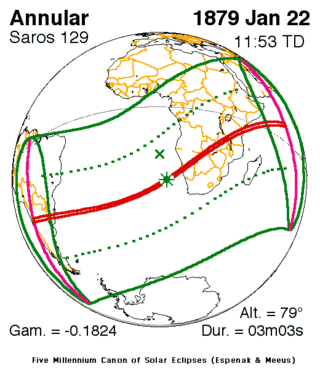Solar eclipse of January 22, 1879
| Solar eclipse of January 22, 1879 | |
|---|---|
 Map | |
| Type of eclipse | |
| Nature | Annular |
| Gamma | -0.1824 |
| Magnitude | 0.97 |
| Maximum eclipse | |
| Duration | 183 sec (3 m 3 s) |
| Coordinates | 29°48′S 8°30′E / 29.8°S 8.5°E |
| Max. width of band | 110 km (68 mi) |
| Times (UTC) | |
| Greatest eclipse | 11:53:08 |
| References | |
| Saros | 129 (44 of 80) |
| Catalog # (SE5000) | 9231 |
An annular solar eclipse occurred on January 22, 1879. A solar eclipse occurs when the Moon passes between Earth and the Sun, thereby totally or partly obscuring the image of the Sun for a viewer on Earth. An annular solar eclipse occurs when the Moon's apparent diameter is smaller than the Sun's, blocking most of the Sun's light and causing the Sun to look like an annulus (ring). An annular eclipse appears as a partial eclipse over a region of the Earth thousands of kilometres wide. The path of totality crossed southern Africa.
Observations
On 22 January 1879 a British battalion was annihilated by Zulu warriors during the Zulu War in South Africa. At 2:29 PM there was a solar eclipse.[1][2] The conflict was named the Battle of Isandlwana, the Zulu name for the battle translates as "the day of the dead moon".[3]
Notes
- ↑ "The Battle of Isandlwana - The Zulu War".
- ↑ "Zulus and British re-enact 1879 battle". Retrieved 11 October 2014.
- ↑ Rattray, David (author) (1997). The Day of the Dead Moon (The Story of the Anglo-Zulu War 1879) (audio) (CD). GTV. ASIN B0010JC3ZU.
References
| Wikimedia Commons has media related to Solar eclipse of 1879 January 22. |
